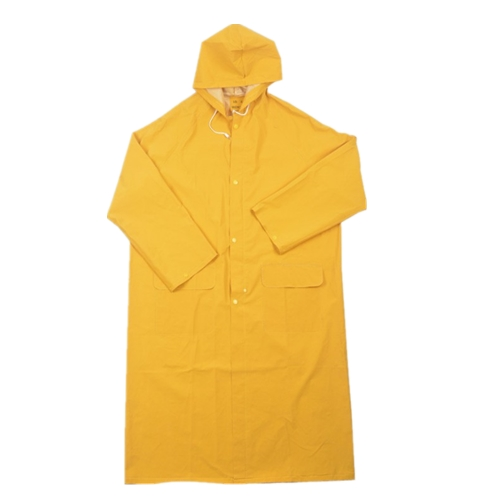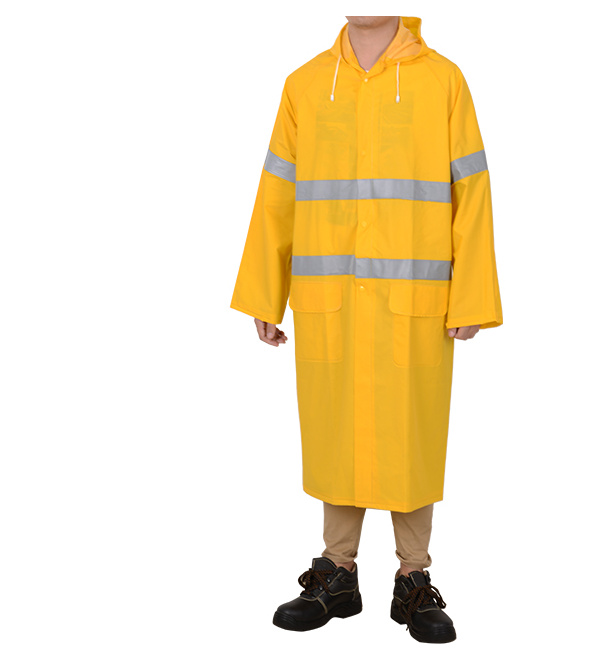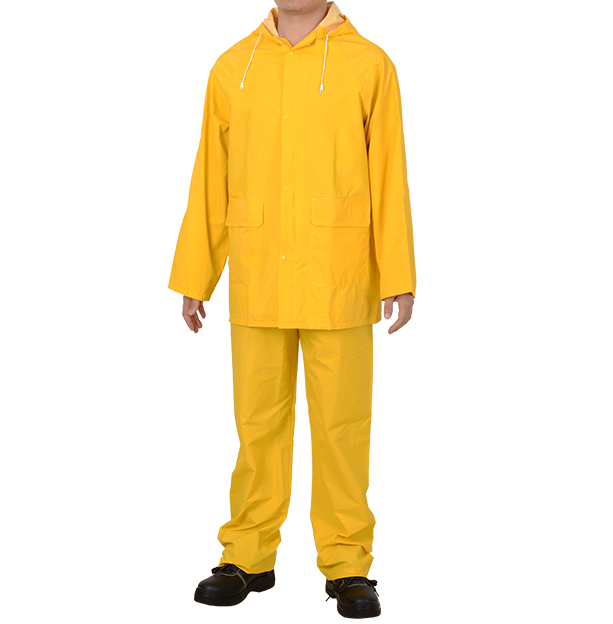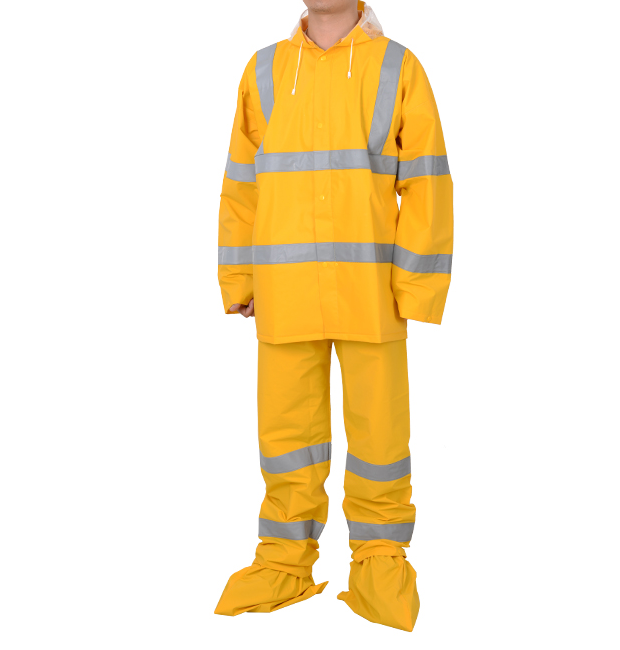When purchasing a PVC raincoat for work, it’s crucial to consider the material composition and its suitability for specific working environments. Different raincoat materials provide varying levels of durability, comfort, and waterproofing. Two of the most common material combinations used by PVC raincoat factories are PVC/Polyester and PVC/Polyester/PVC. Both options offer unique advantages, depending on the intensity and nature of the work.

PVC/Polyester Raincoat: Moderate Protection for Everyday Work
Material Composition:
- PVC: PVC raincoat factories often choose fabric with outer layer in PVC, offering robust waterproofing and protection from rain and wind.
- Polyester: The inner layer is polyester, which provides comfort, flexibility, and breathability.
Key Properties:
- Waterproofing: The PVC outer layer offers high waterproofing, ensuring workers remain dry during moderate rain.
- Durability: This raincoat performs well in general industrial settings but may wear faster with heavy abrasion.
- Flexibility: The polyester inner layer allows for easier movement and greater comfort during extended wear.
- Lightweight: Compared to other raincoat types, PVC/Polyester raincoats are relatively light and easy to wear.
- Breathability: The polyester layer promotes airflow, preventing excessive sweating during physical activity.
- Affordability: This combination is typically more affordable, making it a cost-effective option for large teams of workers.
Applications:
- General Industrial Work: Ideal for light industrial environments where workers are exposed to moderate rain.
- Construction & Transport: Perfect for workers who require waterproofing during short-term outdoor use.
- Agriculture: Suitable for farm workers facing mild rainfall.

PVC/Polyester/PVC Raincoat: Heavy-Duty Protection for Extreme Conditions
Material Composition:
- PVC: This raincoat features two layers of PVC, one on the outer layer and one inside. PVC raincoat factories select the fabric for superior waterproofing.
- Polyester: The middle layer is made of polyester, which provides flexibility and comfort, preventing the raincoat from becoming too stiff.
Key Properties:
- Superior Waterproofing: With two PVC layers, this raincoat ensures maximum protection from rain and wind.
- Enhanced Durability: The dual PVC layers increase the resistance to wear and tear, making it ideal for extreme conditions.
- Insulation: The inner PVC layer helps provide extra warmth by blocking out cold air and wind.
- Heavier Weight: This raincoat is thicker and heavier than the PVC/Polyester version but provides additional protection.
- Reduced Flexibility: While not as flexible, the polyester middle layer helps maintain comfort and flexibility.
- Long-Lasting Protection: Designed for heavy-duty use, it withstands prolonged exposure to harsh elements.
Applications:
- Heavy Industrial Work: Perfect for industries like oil and gas, mining, and chemical processing, where workers need extreme protection.
- Chemical Handling: The dual PVC layers offer enhanced protection against hazardous chemicals.
- Marine and Fishing Industries: This raincoat provides robust protection for workers exposed to water for extended periods.
- Agriculture: Effective for workers in regions that face persistent rainfall or when handling water-intensive tasks.
Comparison: PVC/Polyester vs. PVC/Polyester/PVC raincoat for work use
| Feature | PVC/Polyester Raincoat | PVC/Polyester/PVC Raincoat |
| Waterproofing | High (single PVC layer) | Very High (double PVC layers) |
| Durability | Good (standard use) | Excellent (heavy-duty use) |
| Breathability | Better (due to polyester) | Moderate (due to dual PVC layers) |
| Weight | Lighter | Heavier |
| Flexibility | High (easy to move) | Moderate (less flexible) |
| Insulation | Low | Moderate (better warmth) |
| Protection | Moderate (general work) | Enhanced (extreme conditions) |
| Cost | More affordable | More expensive |
| Best for | General industrial, agriculture | Heavy-duty, extreme weather |

Which One Should You Choose for Work?
PVC/Polyester Raincoat:
- Best for lighter to moderate industrial use.
- Ideal for tasks where comfort and waterproofing are the top priorities, but extreme conditions are not expected.
- More affordable than PVC/Polyester/PVC options, making it ideal for large workforces.
- Provides excellent flexibility and breathability, allowing for comfortable all-day wear.
- Suitable for industries like logistics, warehousing, and construction.
PVC/Polyester/PVC Raincoat:
- Best for heavy-duty, hazardous environments.
- Ideal for industries that face extreme weather or hazardous working conditions, such as chemical plants, oil rigs, and mining.
- The dual PVC layers offer maximum waterproofing and durability.
- Provides additional insulation and protection from chemicals, making it perfect for industrial applications with constant exposure to tough conditions.
Conclusion
When purchasing a PVC raincoat for work, choosing the right material composition is essential. PVC/Polyester raincoats are a great option for light to moderate industrial use, offering comfort, flexibility, and cost-effectiveness. However, for industries exposed to severe weather or extreme conditions, PVC/Polyester/PVC raincoats provide superior durability, insulation, and waterproofing.
For PVC raincoat factories and suppliers in China, understanding these differences can help you make the right choice for your workforce’s needs. Whether you need a work raincoat, safety raincoat, or yellow raincoat for high visibility, each type of material composition provides unique benefits depending on the working conditions.

Choose the raincoat that best suits your environment and budget. If you require long-lasting protection in harsh conditions, the PVC/Polyester/PVC raincoat will provide superior results. On the other hand, if you only need protection from light rain and are looking for a more cost-effective solution, the PVC/Polyester combination is the ideal choice.


